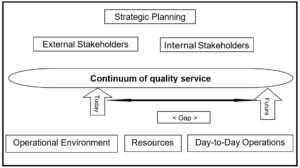
When I think of strategic planning, I think of strategic thinking, strategic planning, and strategic foresight.
Definitions
Strategic Thinking is about collecting information, evaluating it and using the information to help a business sustain its competitive edge…or relevance for those in government organizations. It is an essential part of the strategic planning and foresight processes.
Strategic Planning is fundamentally about asking ourselves the question, “If we are here, how do we get there?” It takes into consideration where we are and builds a bridge to where we want to go.
Strategic Foresight involves identifying emerging trends and how those will impact your organization; selecting a preferred future, often by engaging scenario planning, and using aspects of the preferred future into the present-day planning.
The Concept of Strategic Planning
I like to use the following diagram to depict the strategic planning process.

The Gap determines where we are with respect to some aspect of our operations, such as quality of service. As a result of our interaction with internal and external stakeholders along with insights into the competition, we may conclude that our quality of service is lacking. In other words, there is a gap between where we are today and where we need to be in the future.
Operating Environment represents the context in which the organization operates both now and in the future. The five aspects that contribute to the operating environment include:
- Society
- Technology
- Environment
- Economy
- Legal
- Politics
Emerging trends often surface in these areas. As we think about closing the gap, we will need to consider both our resources and the realities of our operation. An example would be the extent to which we have the talent or technology to close the gap, as well understanding what our competition is doing and how customer/stakeholder perspectives are changing.
Logistics of Strategic Planning
There is always a very real tension between day-to-day operations and moving an organization in a different direction. The tyranny of the urgent is often the enemy of planning and implementing new initiatives.
I, Merle, was teaching a strategic planning class to a group of middle-managers. Two managers asked, “Why is strategic planning a part of this program? We have never seen strategic planning work. Yes, our organization does strategic planning, but the plan sits on the shelf and isn’t used.” Would managers in your organization say the same?
I worked with a leadership team that engaged me to help them update their strategic plan. I asked if I could survey employees and ask a few questions:
- Have you ever seen the strategic plan?
- Has your supervisor/manager ever discussed the strategic plan?
The results were bad. The overwhelming majority had never seen the strategic plan and fewer yet had held a conversation with a supervisor or manager about the strategic plan.
How would this impact the implementation of any plan? Planning cannot stand without application.
Implementation of Strategic Planning
Five Common Pitfalls and Solutions:
I urge you to highlight any of the 5 that resonate and create a plan to introduce transformation in your organization.
Separating Thinking from Doing: Sometimes senior management will develop a plan without engaging those who will implement the plan. Engage those who will be doing the work during the planning process to create a cohesive practical plan.
Assuming the Environment will Stay the Same: The environment in which you operate is constantly changing. Make the plan a living document and adapt.
Yielding to the Urgent: The urgent but not important items derail organizations productivity. Turn thinking and planning into a priority. Dave Dias, VP, Interwest Insurance Services, Inc. suggests dividing the day into Green and Red time.
Green time is customer/vendor time between 8 am – 6 pm. Red time is before 8 am and after 6 pm……for planning/strategic/reflective/project and thinking time. Never confuse the two.
Lack of Follow Through: The team won’t care if you don’t care. Hold yourself and others accountable for following through on the plan.
Lack of Involvement: Get as many people involved in the planning and implementation process as possible. People support what they help to create.
Reflection:
- How will you, as a leader, get your head above water to do thinking and planning?
- Who can help you?
- Are you committed to following through?
You can do it, but it takes discipline. Need help? We’ve got you covered, so give us a call.
For the Faith-Based Reader:
“Do not reprove a scoffer, or he will hate you; reprove a wise man, and he will love you. Give instruction to a wise man, and he will be still wiser; teach a righteous man, and he will increase in learning. ” Proverbs 9:8-9
Invest in your organization, to teach and instruct your team to develop. Strategic planning places clear expectations and hopes as employees develop in wisdom. Create a culture that loves reproof, for it leads to improvement and bettering of the wise and weeds out the scoffers.